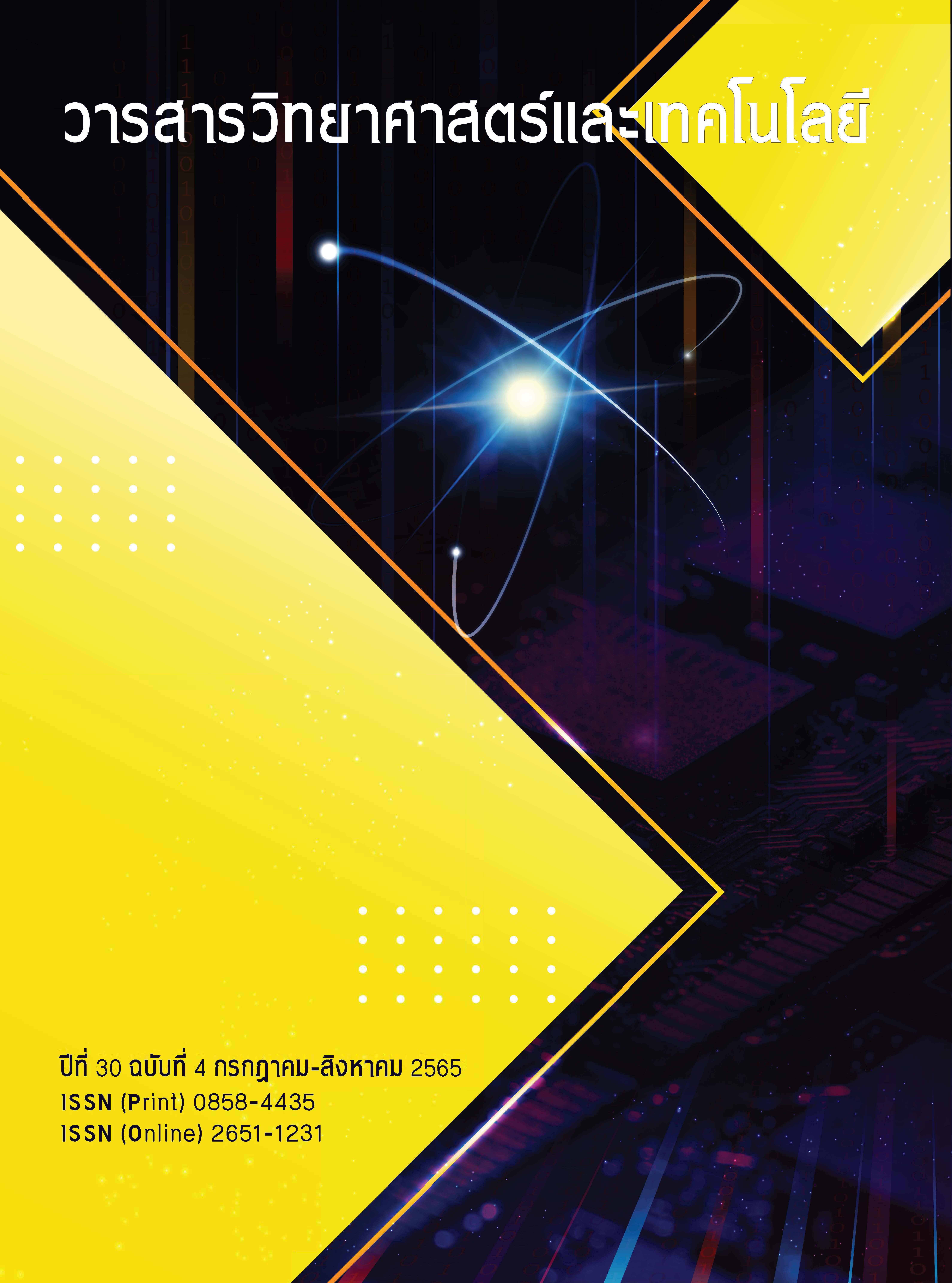การเพิ่มจำนวนยอดและปริมาณสารต้านอนุมูลอิสระของยอดไผ่ซางหม่นที่พัฒนาในสภาพปลอดเชื้อ
Main Article Content
บทคัดย่อ
ไผ่ซางหม่น (Dendrocalamus sericeus) เป็นไผ่ชนิดหนึ่งที่มีประโยชน์หลากหลายด้าน และมีความต้องการใช้มากขึ้น จึงจำเป็นต้องเพิ่มจำนวนยอดด้วยการเพาะเลี้ยงเนื้อเยื่อ รวมถึงวิเคราะห์หาปริมาณสารทุติยภูมิของยอดไผ่เพื่อใช้ในอุตสาหกรรมยาและเครื่องสำอาง การทดลองนี้จึงมีวัตถุประสงค์เพื่อศึกษาหาสูตรอาหารและสถานะของอาหารที่เหมาะสมต่อการเพิ่มจำนวนยอด รวมถึงปริมาณสารทุติยภูมิของยอดไผ่ซางหม่นในสภาพปลอดเชื้อ ทำการเพาะเลี้ยงชิ้นส่วนข้อไผ่ซางหม่น บนอาหารแข็งสูตร Murashige and Skoog (MS) ที่เติม 6-benzyladenine (BA) ความเข้มข้น 0 1 2 และ 3 mg/L ร่วมกับ 1-naphthaleneacetic acid (NAA) ความเข้มข้น 0 และ 0.5 mg/L และเพาะเลี้ยงกลุ่มยอด 2 – 3 ยอดในอาหารเหลว และบนอาหารแข็งสูตร MS ที่เติม BA ความเข้มข้น 2 mg/l ร่วมกับน้ำมะพร้าวความเข้มข้น 0 8 และ 15% (v/v) นาน 4 สัปดาห์ พบว่า อาหารเหลวสูตร MS ที่เติม BA ความเข้มข้น 2 mg/l ร่วมกับน้ำมะพร้าวความเข้มข้น 8% (v/v) ส่งผลดีต่อการเพิ่มจำนวนยอดของไผ่ซางหม่น โดยมียอดใหม่ที่พัฒนาสูงสุด 4.67 ± 0.02 ยอด และมีความยาวยอด 2.51 ± 0.35 cm เมื่อนำยอดไผ่ซางหม่นที่เพาะเลี้ยงในอาหารเหลวสูตรดังกล่าวมาวิเคราะห์หาปริมาณสารต้านอนุมูลอิสระเปรียบเทียบกับยอดอ่อนและใบที่เจริญเติบโตเต็มที่จากต้นที่ปลูกในสภาพธรรมชาติ พบว่า ยอดในสภาพปลอดเชื้อ มีปริมาณสารประกอบฟีนอลิคทั้งหมด (63.80 ± 1.31 mg GAE/g dry extract) สารฟลาโวนอยด์สูงกว่า (32.18 ± 1.95 mg CE/g dry extract) และมีฤทธิ์ต้านอนุมูลอิสระ (DPPH EC50 = 169.17 ± 11.46 µg/ml และ ABTS EC50 เท่ากับ 299.39 ± 68.93 µg/ml) ดีกว่ายอดอ่อนและใบที่เจริญเติบโตเต็มที่จากต้นที่ปลูกในสภาพธรรมชาติ
Article Details
References
Phungchik, T., 2010, Study of bamboo collection and production technology of Bambusa nana for sustainable agriculture: Bamboo collection, Journal of Forest Management (Thailand) 4: 60-73. (in Thai)
Austin, R., Dana, L. and Koichiro, U., 1983, Bamboo, Weatherhill, New York. 215 p.
Kaveeta, R., 1998, Plant Tissue Culture: Principles and Techniques, 2nd edition, Faculty of Agriculture, Kasetsart University, Bangkok, 219 p. (in Thai)
Prutpongse, P. and Gavinlertvatana, P., 1992, In vitro micropropagation of 54 species from 15 genera of bamboo, HortScience 27: 453-454.
Chanlhanuraksa, S., 1991, Bamboo tissue culture: Effect of 2, 4-D, NAA and BAP on callus and shoot formation, Ph.D. Thesis,
Kasetsart University, Bangkok.
Godbole, S., Sood, A., Thakur, R., Sharma, M., and Ahuja, P. S., 2002, Somatic embryogenesis and its conversion into plantlets in a multipurpose bamboo, Dendrocalamus hamiltonii Nees et Arm. Ex Munro., Curr. Sci. 83: 885-889.
Lv, Z., Dong, J. and Zhang, B., 2011, Rapid identification and detection of flavonoid compounds from bamboo leaves by LC-(ESI)-IT-TOF/MS, Bioresources 7: 1405-1418.
Jiao, J., Zhang, Y., Liu, C., Liu, J., Wu, X. and Zhang, Y., 2007, Separation and purification of tricin from an antioxidant product derived from bamboo leaves, J. Agric. Food Chem. 55: 10086–10092.
Gong, J., Huang, J., Xiao, G., Chen, F., Lee, B., Ge, Q., You, Y., Liu, S., and Zhang, Y.,2016, Antioxidant capacities of fractions of bamboo shaving extract and their antioxidant components, Molecules 21:996-1008.
Karawak, P., Thepsithar, C., Sengsai, S., Maksup, S., 2019, Determination of flavone C-glycosides in bamboo leaf extract of Pai Sang Mon "Nuan Rajinee" using TLC and HPLC techniques, Veridian E-Journal, Science and Technology Silpakorn University 6: 84-94. (in Thai)
Ramachandra Rao, S. and Ravishankar, G. A., 2002, Plant cell culture: chemical factories of secondary metabolites, Biotechnol. Adv. 20: 101-153.
Jirakiattikul, Y., Rithichai, P., Songsri, O., Ruangnoo, S., Itharat, A., 2016, In vitro propagation and bioactive compound accumulation in regenerated shoots of Dioscorea birmanica Prain & Burkill, Acta Physio. Plant 38:249
Wu, C. F., Karioti, A., Rohr, D., Bilia, A. R. and Efferth, T., 2016, Production of rosmarinic acid and salvianolic acid B from callus culture of Salvia miltiorrhiza with cytotoxicity towards acute lympho- blastic leukemia cell, Food Chem. 201:292-297.
Autaijamsripon, J., Jirakiattikul, Y. Rithichai, P. and Itharat, A., 2017, Effect of culture periods on secondary metabolite contents and antioxidant activity of in vitro Bacopa monnieri shoots. Thai Sci. Technol. J. 25: 443-452. (in Thai)
Yusuf, N. A., Rahim, N. S. M., Azhar, S. Z. A., Ghani, K. A., Sommano, S. and Khalid. N., 2018, Adventitious root cultures of Boesenbergia rotunda as a source of pinostrobin, Int. J. Adv. Sci. Eng. Inf. Techno. 8: 337-383.
Yamasaki, K., Hashimoto, A., Kokusenya, Y., Miyamoto, T. and Sato, T., 1994, Electrochemical method for estimating the antioxidative effect of methanol extracts of crude drugs, Chem. Pharmaceut. Bull.42: 1663-1665.
Re, R., Pellegrini, N., Proteggente, A., Pannala, A., Yang, M. and Rice-Evans, C., 1999, antioxidant activity applying an improved ABTS radical cation decolorization assay, Free Rad. Biol. Med. 26: 1231- 1237.
Kapruwan, S., Kaur, M. and Bakshi, M., 2014, Effect of growth regulators on the in vitro multiplication of Dendrocalamus Hamiltonii, Int. J. Eng. Res. Appl. 4: 83-86.
Ramanayake, S. M. S. D. and Yakandawala, K., 1997, Micropropagation of the giant bamboo (Dendrocalamus giganteus Munro) from nodal explant of field growth culms, Plant Sci. 129: 213-223.
Kaladhar, D. S. V. G. K., Tiwari, P. and Duppala, S. K., 2017, A rapid in vitro micropropagation of Bambusa vulgaris using inter- node explant, Int. J. Life. Sci. Scienti. Res. 3: 1052-1054.
Neumann, K. H., Kumar, A. and Imani, J., 2009, Plant Cell and Tissue Culture – A Tool in Biotechnology: Basics and Application, Springer-Verlag, Berlin and Heidelberg, 325 p.
Molnár, Z., Virág, E. and Ördög, V., 2011, Natural substances in tissue culture media of higher plants, Acta Biol. Szeged. 55: 123-127.
Dongmanee, A., 2006, Micropropagation of Pai Ruak (Thyrsostachys siamensis), M.Sc. Thesis, Silpakorn University, Nakhorn Pathom.
Ramanayake, S. M. S. D. and Yakandawala, K., 1997, Micropropagation of the giant bamboo (Dendrocalamus giganteus Munro) from nodal explant of field growth culms, Plant Sci. 129: 213-223.
Shank, L. P., Riyathong, T., Lee, V. S. and Dheeranupattana, S., 2013, Peroxidase activity in native and callus culture of Moringa oleifera Lam., Journal of Medicinal and Bioengineering. 2: 163-167.
Wu, C. F., Karioti, A., Rohr, D., Bilia, A. R. and Efferth, T., 2016, Production of rosmarinic acid and salvianolic acid B from callus culture of Salvia miltiorrhiza with cytotoxicity towards acute lymphoblastic leukemia cell, Food Chem. 201:292-297.
Matkowski, A., 2008, Plant in vitro culture for the production of antioxidants – a review, Biotechnol. Adv. 26: 548-560.

